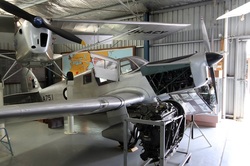Percival Proctor 1 VH-AUC
 Click on image for larger version
Click on image for larger version
Edgar Percival was born in Albury, New South Wales in 1898. Following service with the Royal Flying Corp during World War 1, Percival operated his own charter company in Australia before returning to England where he was appointed as an Air Ministry test pilot.
His interest in aircraft design led him to form his own aircraft company at Gravesend, Kent in 1934. He designed the very successful "Gull" series of racing and touring aircraft through the 1930s that were noted for their graceful lines and outstanding performance. Charles Kingsford Smith flew a Percival Gull Four named ‘Miss Southern Cross’ from England to Australia in the record breaking time of 7 days 4 hours and 44 minutes. The New Zealand aviatrix, Jean Batten, also used the Percival Gull to fly from England to Australia in October 1936.
The genesis of the Percival Proctor was the Percival "Vega Gull", re-designed as a three seat radio training machine for the RAF Bomber Command in 1941 and powered by a de Havilland 210hp Gipsy Queen, 6 cylinder inverted inline engine. The Proctor Mks1,2 and 3 retained the aerodynamic qualities of the "Vega Gull" and performance whereas later Mks 4 and 5 while of similar appearance were heavier, less aerodynamic and underpowered with the same 210hp de Havilland Gipsy Queen engine.
All Proctors were built in Britain and thirty odd were imported into Australia post WW2. The wooden structure became suspect of glue bonding failure in the 1950s, and eventually led to all Proctors on the Australian Register of Aircraft being grounded by the Department of Civil Aviation (DCA)
The Museum's Proctor Mk1 arrived in Australia in 1951, registered VH-AUC and owned by Neville Crisp of New South Wales. Ferried to Moorabbin in 1957 it was sold to Brian Treloar of South Australia who operated it until donating the airframe to the Museum in 1965. In storage until 1972 after which a seven year restoration project was commenced and completed in 1979 with the help of components from several dismantled Proctors acquired earlier.
The finished article was given the RAAF serial of A75-1 to represent the Proctor of the Governor General's Flight that was in existence in 1947 to 1949. It is currently on display at the Museum.
TECHNICAL DATA
Crew : 1 pilot.
Passengers : 2.
Power plant : 1 x 210hp de Havilland Gipsy Queen, 6 cylinder inverted inline engine.
Length : 28'02'' (8.5m) Wingspan : 39'06'' (12.04m) Height : 7'03'' ( 2,2m)
Weights : empty - 2,340lbs (1,061kg) maximum : 3,500lbs (1,584kg)
Speeds : maximum - 136kt (157mph) ( 253km/hr) cruise - 117kt (135mph ) (217km/hr)
Range : 500miles (800km)
